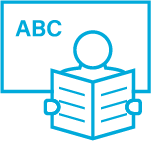This systematic review and meta-analysis investigated the efficacy of spelling interventions for the remediation of dyslexia and spelling deficits. Results show that treatment approaches using phonics and orthographic and morphological instruction had a moderate-to-high impact on spelling performance.
Authors: Katharina Galuschka, Ruth Görgen, Julia Kalmar, Stefan Haberstroh, Xenia Schmalz & Gerd Schulte-Körne
Source: Galuschka, K.; Görgen, R.; Kalmar, J.; Haberstroh, S.; Schmalz, X.; Schulte-Körne, G. (2020). Effectiveness of spelling interventions for learners with dyslexia: A meta-analysis and systematic review. Educational Psychologist, 55(1), 1–20. DOI: 10.1080/00461520.2019.1659794
This systematic review and meta-analysis investigated the efficacy of spelling interventions for the remediation of dyslexia and spelling deficits. The study included 34 controlled trials that evaluated spelling interventions in children, adolescents, and adults with dyslexia and spelling deficits. Results show that treatment approaches using phonics and orthographic and morphological instruction had a moderate-to-high impact on spelling performance. Significant influence of interventions that teach memorisation strategies to improve spelling could not be confirmed.
- Learning to spell is a challenging task.
- In most alphabetic orthographies, spelling skills are more difficult to acquire than reading skills.
- Difficulties with spelling (such as adding, omitting, or substituting letters or graphemes in written words) are a common indicator of specific learning disorders and a core characteristic of dyslexia.
- The term dyslexia refers to a pattern of learning difficulties characterised by problems with word recognition, decoding, and spelling.
- Poor spelling is an obstacle for text production in the same way that difficulties in word recognition are an impediment for reading comprehension.
- Spelling not only affects writing and compositional skills but is also closely linked to reading.
- In some phases, spelling is essential for reading because it trains phoneme awareness and the alphabetic principle. In other phases, reading boosts spelling because reading exposure leads to a richer lexicon of orthographic representations.
- Phonological awareness skills and the ability to segment spoken words into phonemes is an important precursor to reading and spelling acquisition.
- It is not surprising that phonological awareness interventions (including oral tasks for recognising phonemes within words, blending phonemes into words, segmenting a word into phonemes, eliminating a phoneme from a word, or adding a phoneme to a word) are often implemented to foster spelling and reading skills.
- Knowledge of phoneme–grapheme and grapheme–phoneme correspondences make up a self-teaching mechanism, which supports the acquisition of orthographic skills and fosters sight word reading (direct retrieval of phonology and semantics associated with a given written word form from the orthographic lexicon).
- Because of the strong influence of phoneme–grapheme and grapheme–phoneme correspondence skills on reading and spelling ability, research on reading and spelling instruction and intervention has predominantly focused on the acquisition of this fundamental knowledge.
- Such treatment approaches are often referred to as phonics interventions.
- Interventions that aim to help children with dyslexia and spelling deficits deal address the deviations from one-to-one mappings between phonemes and graphemes and provide explanations for these deviations by explicitly teaching morphological or orthographic knowledge.
Morphological knowledge
- This refers to awareness of the smallest meaningful language units.
- Morphological interventions for younger children often include the practice of inflections, whereas morphological interventions for older children often focus on derivations.
Orthographic knowledge
- This refers to understanding of the orthographic rule system that allows correct writing in terms of rules and patterns of written language.
- Interventions that foster orthographic skills mainly focus on graphotactic and phonological–orthographic regularities.
Orthographic depth
- This is generally conceptualised as orthographic consistency: the presence of more than one pronunciation for a given letter or cluster of letters, or the presence of multiple spellings for one phoneme.
- Consistency thus measures the extent of adherence to the alphabetic principle, which varies greatly between orthographies.
- The Finnish language has been shown to be on the ‘consistent’ end of the orthographic consistency continuum, both in reading and spelling direction.
- English is on the opposite end of this continuum.
- The higher the number and complexity of rules, the number of exceptions, and sources of inconsistency of an orthography, the more difficult it is to impart this knowledge and to use it for the remediation of spelling deficits.
- For interventional research on spelling, it is important to know if there are treatment approaches that are less effective in one orthography than in another.





